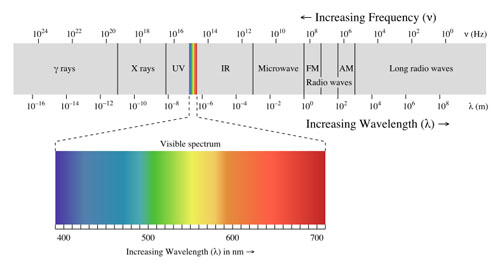, image, although in a minority of cases the spread may be slightly wider. It is completely blind to the vast majority of the radiation in which the world is bathed. If it were not, the human experience would certainly be very different. Beyond the blue end of the visible spectrum the wavelengths shorten as radiation enters the higher-energy ultraviolet, x-ray and gamma ray regions.
 |
| Image by kind permission of Philip Ronan via Wiki Commons |
At the red end of the visible spectrum, where the longer wavelengths are found, visible radiation merges with that of the infrared spectrum and disappears from human view. However, inability to see infrared does not mean that it cannot be detected in other ways. In broad terms the infrared spectrum represents what is commonly known as heat, a well-known but invisible phenomenon accepted as part of everyday life. The infrared spectrum is usually divided into three sections known as near, middle and far infrared. The near part of the spectrum is the one that adjoins the red end of the visible spectrum. It has wavelengths in the range 780 nm to 3,000 nm. As wavelengths increase beyond the middle and far sections of infrared, the radiation is described as microwaves or radio.
Infrared photography relies on the ability to manufacture films or sensors which exhibit sensitivity to the appropriate region of the electromagnetic spectrum. Currently available films are sensitive to wavelengths up to about 850 nm, which represents only a small portion of the near infrared spectrum. Nevertheless, the ability to capture in an image radiation energy which cannot be seen with the naked eye opens up a whole new world of photographic opportunities.
Normal film emulsions are sensitive only to visible light and some ultraviolet radiation, but infrared films employ chemistry which is sensitive to visible and some near infrared radiation. To obtain the most interesting results, it is therefore necessary to filter out as much as possible of the visible light. The image on the infrared film is then formed largely from the invisible radiation in the near infrared spectrum. If no filtration is used, image formation will still be dependent to a large extent upon visible radiation.
A number of different filter types can be employed, but the most effective is the so-called opaque filter which effectively blocks all visible light, but passed near infrared radiation. Other filters, such as a dark red or yellow, block some of the visible light but do not give such interesting results.